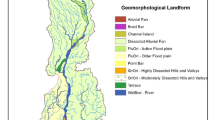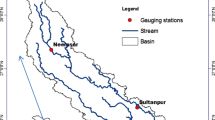Abstract
Accurate streamflow data, which constitute the basic component in estimating seepage losses or gains in streamflow are in short supply in developing countries. The lack of either financial or technical resources, or both, and at times, the lack of understanding of the importance of accurate streamflow measurements in supporting modeling and water resources decision making process hinder the installation and proper maintenance of streamflow gauges. Therefore, the current study adopted the aim of demonstrating the feasibility of utilizing alternative streamflow data sources in hydrologic studies. In the current study, such sources included effluent from a large wastewater treatment plant as an inflow to the river segment under consideration while the outflow from the same river segment was taken to be the flow discharged into a dam reservoir as calculated from daily dam reservoir water balance. A water balance was established for a 48 km segment on the Zarqa River in Jordan with components covering the inputs of discharge from springs, and wastewater treatment plants and outputs such as direct evaporation, and surface withdrawals for irrigation purposes. Channel seepage was estimated as the difference between inputs and outputs of the river segment water balance. Final results demonstrated the feasibility of utilizing non-traditional data sources, whenever available, to conduct analysis that traditionally has not been possible.







Similar content being viewed by others
Abbreviations
- AZB:
-
Amman–Zarqa Basin
- CC:
-
Crop consumption
- JMD:
-
Jordan Meteorological Department
- KSWWTP:
-
Kherbit Elsamra Wastewater Treatment Plant
- KTDR:
-
King Talal Dam Reservoir
- MCM:
-
Million cubic meters
- MWI:
-
Ministry of Water and Irrigation
- WAJ:
-
Water Authority of Jordan
References
Abdulrazzak MJ (1995) Losses of flood water from alluvial channels. Arid Land Res Manage 9(1):15–24
Abdulrazzak MJ, Morel-Seytoux HJ (1983) Recharge from an ephemeral stream following wetting front arrival to water table. Water Resour Res 19(1):194–200
Al Farajat M, Ansari AL, Mashagbeh A, Abou Salah A, R (2005) Hydrogeophysical and environmental investigations of groundwater potentials in Al Sokhna alluvium aquifer in Zarqa—Jordan. J Dep Hydrogeol Environ Univ Würzburg Ger 33(7):1–15 (10 Abb., 8 Tab)
Alam MM, Bhutta MN (2004) Comparative evaluation of canal seepage investigation techniques. J Agric Water Manage 66:65–76
Al-Zyoud S, Rühaak W, Forootan E, Sass I (2015) over exploitation of groundwater in the centre of Amman Zarqa Basin—Jordan: evaluation of well data and GRACE satellite observations. Resources 4(4):819–830
Arnott S, Hilton J, Webb BW (2009) The impact of geological control on flow accretion in lowland permeable catchments. Hydrol Res 40(6):533–543
Bajjali W, Al-Hadidi K, Ismail M (2015) Water quality and geocheistry evaluation of the groundwater upstream and downstream of the Khirbet Al-Smara wastewater treatment plant/Jordan. J Appl Water Sci 5:1–17
Calver A (2001) Riverbed permeabilities: information from pooled data. Groundwater 39(4):546–533
Cey EE, Rudolph DL, Parkin GW, Aravena R (1999) Quantifying groundwater discharge to a small perennial stream in southern Ontario Canada. J Hydrol (Amsterdam) 210(1/4):21–37
Cook PG (2015) Quantifying river gain and loss at regional scales. J Hydrol 531:749–758
Dagès C, Voltz JG, Lacas O, Huttel O, Negro S, Louchart X (2008) An experimental study of water table recharge by seepage losses from a ditch with intermittent flow. Hydrol Process 22:3555–3563
Fipps G (2005) Potential water savings in irrigated agriculture for the Rio Grande Planning Region (Region M), 2005 Update. Texas Water Resour Inst., Texas A&M Univ., College Station
Goodrich DC, Williams DG, Unkrich CL, Hogan JF, Scott RL, Hultine KR, Pool D, Coes AL, Miller S (2004) Comparison of methods to estimate ephemeral channel recharge, Walnut Gulch, San Pedro River Basin, Arizona. In: Phillips FM, Hogan JF, Scanlon B (eds) Groundwater recharge in a desert environment: the southwestern United States. American Geophysical Union, Washington DC, pp 77–99
Gu R, Deutschman M (2001) Hydrologic assessment of water losses in river. J Water Resour Plann Manage 127:6–12
Harte PT, Kiah RG (2009) Measured river leakages using conventional streamflow techniques: the case of Souhegan River, New Hampshire, USA. Hydrogeology 17(2):409–424
Izbicki JA (2002) Geologic and hydrologic controls on the movement of water through a thick, heterogeneous unsaturated zone underlying an intermittent stream in the western Mojave Desert, southern California. Water Resour Res 38(3):2-1–2-14
Kalbus E, Reinstorf F, Schirmer M (2006) Measuring methods for groundwater-surface water interactions: a review. Hydro Earth Syst Sci 10:873–887
Kinzli K-D, Martinez M, Oad R, Prior A, Gensler D (2010) Using an ADCP to determine canal seepage loss in an irrigation district. Agric Water Manage 97(6):801–810
Lange J (2005) Dynamics of transmission losses in a large arid stream channel. J Hydrol 306:112–126
Langhoff JH, Rasmussen KR, Christensen S (2006) Quantification and regionalization of groundwater-surface water interaction along an alluvial stream. J Hydrol 320:342–358
Martin CA, Gates TK (2014) Uncertainty of canal seepage losses estimated using flowing water balance with acoustic Doppler devises. J Hydrol 517:746–761
McKenzie RS, Craig AR (2001) Evaluation of river losses from the Orange River using hydraulic modelling. J Hydrol 241:62–69
Morin E, Grodek T, Dahan O, Benito G, Kulls C, Jacoby Y, Van Langenhove G, Seely M, Enzel Y (2009) Flood routing and alluvial aquifer recharge along the ephemeral arid Kuiseb River, Nambia. J Hydrol 368:262–275
Niswonger R, Prudic D, Fogg G, Stonestrom D, Buckland E (2008) Method for estimating spatially variable seepage loss and hydraulic conductivity in intermittent and ephemeral streams. Water Resour Res 44(5):W05418
Opsahl SP, Chapal SE, Hicks DW, Wheeler CK (2007) Evaluation of groundwater and surface-water exchanges using streamflow difference analyses. J Am Water Resour Assoc 43:1132–1141
Ruehl C, Fisher AT, Hatch C, Los Hueryos M, Stemlet G, Shennan C (2006) Differential gauging and tracer tests resolve seepage fluxes in a strongly-losing stream. J Hydrol 330:235–248
Schmadel NM, Neilson BT, Stevens DK (2010) Approaches to estimate uncertainty in longitudinal channel water balances. J Hydrol 394:357–369
Shahin M (2007) Water resources and hydrometeorology of the Arab region. Springer, Dordrecht
Shaikh IA, Lee TS (2015) Estimating earthen tertiary water channel seepage losses as a function of soil texture. J Hydrol Eng 21:2 (06015012)
Shanafield M, Cook PG (2014) Transmission losses, infiltration and groundwater recharge through ephemeral and intermittent streambeds: a review of applied methods. J Hydrol 511:518–529
Shaqour F, Taany R, Rimawi O, Saffarini G (2015) Quantifying specific capacity and salinity variability in Amman Zarqa Basin, Central Jordan, using empirical statistical and geostatistical techniques. J Environ Monit Assess 188(1):1–17
Sorman AU, Abdulrazzak MJ (1993) Infiltration-recharge through Wadi beds in arid regions. Hydrol Sci J 38(3):173–186
Subyani AM (2004) Use of chloride-mass balance and environmental isotopes for evaluation of groundwater recharge in the alluvial aquifer, Wadi Tharad, western Saudi Arabia. Environ Geol 46(6):741–749
Tanji KK, Kielen NC (2002) Agricultural drainage water management in arid and semi-arid areas. In: FAO irrigation and drainage paper no. 61. Food and Agriculture Organization of the United Nations, Rome, Italy
Villeneuve S, Cook PG, Shanafield M, Wood C, White N (2015) Groundwater recharge via infiltration through an ephemeral riverbed, central Australia. J Arid Environ 117:47–58
Vogt T, Schneider P, Hahn-Woernle L, Cirpka OA (2010) Estimation of seepage rates in a losing stream by means of fiber-optic high-resolution vertical temperature profiling. J Hydrol 380:154–164
Yussuff SMH, Chauhan HS, Kumar M, Srivastava VK (1994) Transient canal seepage to sloping aquifer. J Irrig Drain Eng 120(1):97–109
Acknowledgements
The authors wish to thank the Jordanian Ministry of Water and Irrigation, the Jordan Valley Authority, the Water Authority of Jordan, and Jordan Meteorological Department (JMD) for providing vital data that allowed us to complete this work.
Author information
Authors and Affiliations
Corresponding author
Rights and permissions
About this article
Cite this article
Alsmadi, M.A., Abdelal, Q. Utilizing non-traditional data sources for estimating channel seepage losses. Environ Earth Sci 77, 641 (2018). https://doi.org/10.1007/s12665-018-7829-0
Received:
Accepted:
Published:
DOI: https://doi.org/10.1007/s12665-018-7829-0




